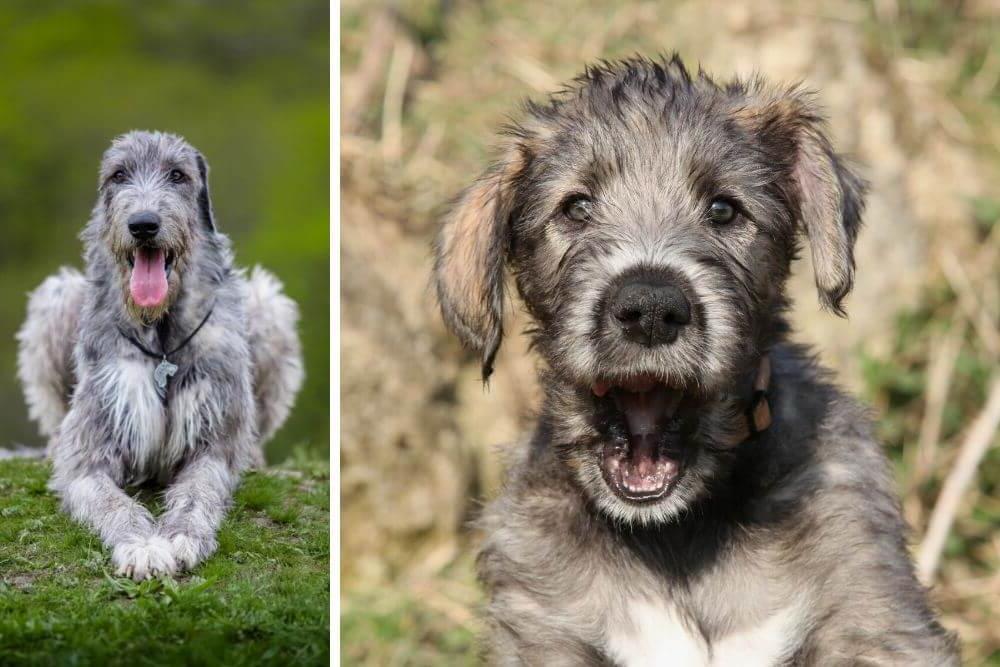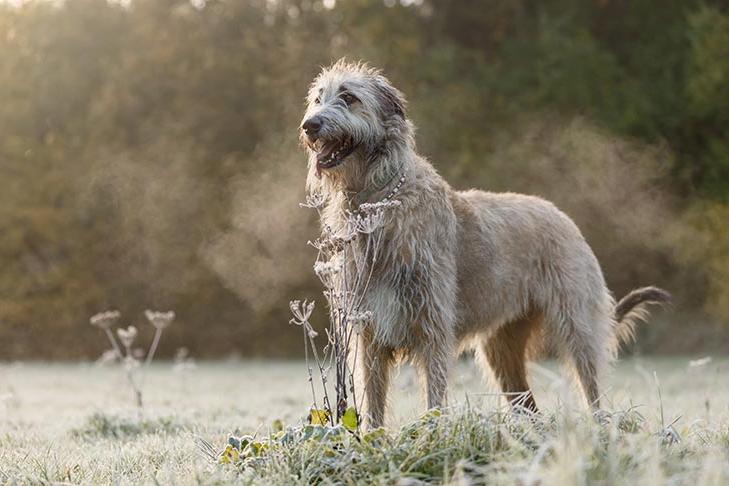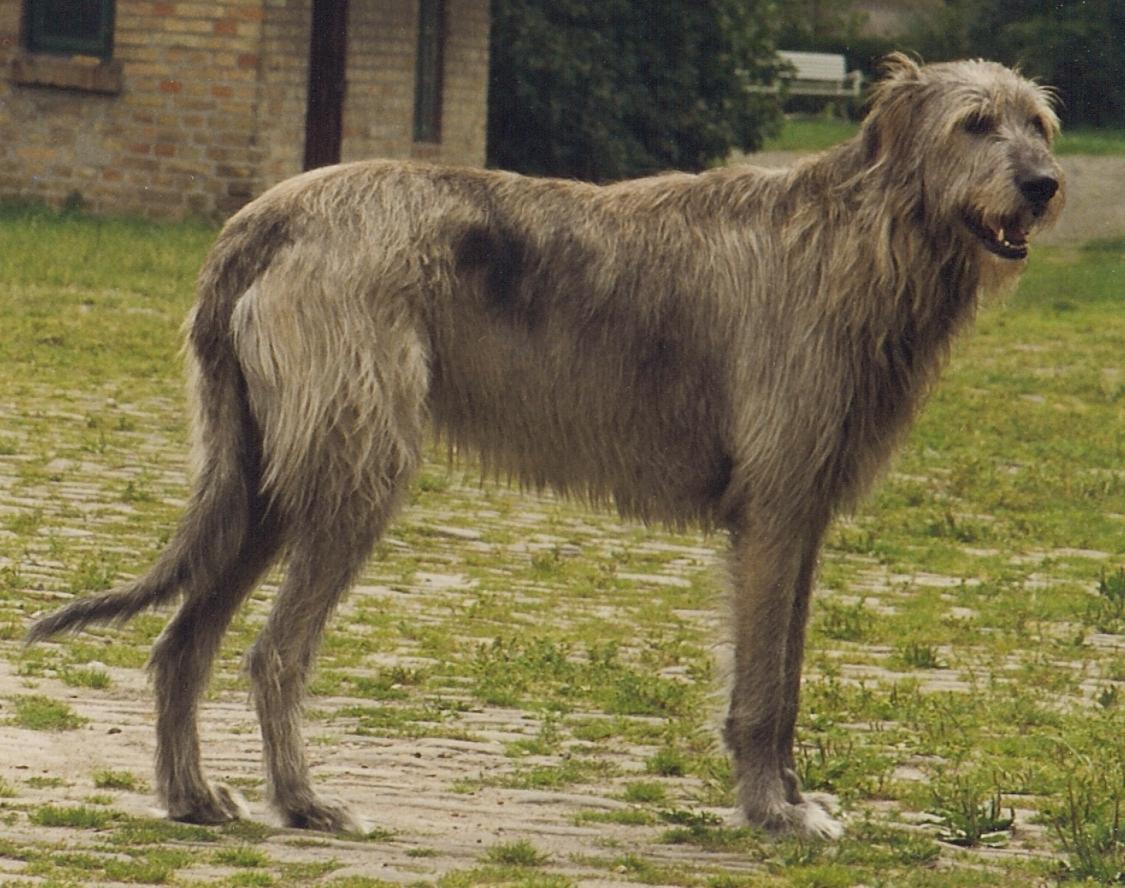- Breed Category: Hound
- Country of Origin: Ireland
- Average Height: Males 81-86 cm (32-34 in), Females 71-81 cm (28-32 in)
- Average Weight: Males 54-70 kg (119-154 lbs), Females 40-60 kg (88-132 lbs)
- Average Life Span: 6-8 years
- Grooming Requirements: Moderate; regular brushing needed
- Exercise Requirements: High; needs daily exercise
- Coat Type: Rough and wiry
- Coat Color Variations: Grey, brindle, red, black, white
- Shedding Level: Moderate
- Ear Type: Small, rose-shaped
- Tail Type: Long, slightly curved
- Temperament: Gentle, friendly, loyal
- Intelligence Level: High
- Barking Tendency: Low
- Compatibility with Children: Very good
- Compatibility with Other Pets: Generally good
- Training Ease: Moderate; responds well to positive reinforcement
- Common Health Issues: Heart disease, bloat, hip dysplasia
- Dietary Needs: High-quality diet, large breed formula
- Energy Level: Moderate
- Drooling Tendency: Low
- Sensitivity to Weather: Sensitive to heat
- Overall Maintenance Level: Moderate
- Original Purpose: Hunting large game
- Year of Recognition by Kennel Clubs: 1879
- Apartment Friendly: Not ideal; needs space
- Best Suited For: Families, active owners, large homes
- Cost of Ownership: High; food and vet bills
- Unique Traits: One of the tallest dog breeds
- Cultural Significance: Symbol of Irish heritage
- Popularity Rank: Moderate
Imagine a dog that stands as tall as a small pony, with a gentle gaze and a history as rich as the emerald hills of Ireland. That’s the Irish Wolfhound for you. Known for their towering height and calm demeanour, these dogs are a blend of strength and grace. This article aims to delve into the unique characteristics, storied history, and essential care tips for this majestic breed.
The Irish Wolfhound’s roots trace back to ancient times, where they were revered for their prowess in hunting wolves and deer. Originating in Ireland, they were companions to nobility and warriors alike. Over centuries, their role evolved, but their noble stature and loyal nature remained unchanged.
Irish Wolfhound: A Majestic Breed with a Storied Past

Early Development of the Breed
The Irish Wolfhound’s lineage stretches back to ancient Ireland, where they were bred for their size and strength. These dogs were initially developed to hunt wolves and large game, a task they performed with remarkable skill. Their impressive stature and keen instincts made them invaluable to the Celtic tribes, who relied on them for both hunting and protection.
Role in Hunting and Guarding
In their prime, Irish Wolfhounds were more than just hunters; they were guardians of the homestead. Their imposing presence was enough to deter intruders, while their speed and agility made them formidable hunters. They were often seen accompanying warriors into battle, a testament to their loyalty and courage.
Key Historical Figures and Events
Throughout history, Irish Wolfhounds have been associated with nobility and royalty. Figures like Cú Chulainn, a legendary hero of Irish mythology, are said to have had these dogs by their side. The breed’s popularity waned over time, but efforts in the 19th century by Captain George Augustus Graham helped revive their numbers, ensuring their legacy continued.
Physical Characteristics
Standing tall and proud, the Irish Wolfhound is one of the largest dog breeds in the world. Their long legs and muscular build give them a commanding presence, while their rough coat and gentle eyes soften their appearance. Despite their size, they are known for their calm and friendly nature, making them gentle giants in every sense.
Appearance and Unique Physical Traits
The Irish Wolfhound is truly a sight to behold. With a height that can rival a small pony, these dogs are among the tallest in the canine world. Their coat is typically rough and wiry, coming in a variety of colours like grey, brindle, red, black, and white. Distinctive markings are rare, but their overall appearance is one of rugged elegance. Their gentle eyes and expressive faces add to their charm, making them look both noble and approachable.
Temperament and Behaviour
Despite their imposing size, Irish Wolfhounds are known for their gentle and friendly nature. They are often described as gentle giants, with a temperament that is calm and patient. These dogs are incredibly loyal and form strong bonds with their families. While they have a history as hunters, today they are more likely to be found lounging around the house, content with a leisurely walk and some quality time with their humans. Their easy-going nature makes them great companions for families and individuals alike.
Personality and Suitability as a Family Pet

Typical Personality Traits
Irish Wolfhounds are the epitome of gentleness. Despite their size, they are incredibly calm and patient, making them perfect companions for those who appreciate a laid-back lifestyle. Their loyalty is unmatched, and they form deep bonds with their families, always eager to be by your side.
Suitability as a Family Pet
These gentle giants are well-suited for family life. Their calm nature means they adapt well to various household dynamics, whether it’s a bustling family or a quieter home. They thrive on companionship and are happiest when included in family activities.
Interaction with Children and Other Animals
Irish Wolfhounds are known for their friendly disposition towards children. Their patience and gentle nature make them excellent playmates, though supervision is always recommended due to their size. They generally get along well with other animals, especially if socialised from a young age.
Training and Exercise Needs
While they are not overly demanding in terms of exercise, Irish Wolfhounds do benefit from regular walks and playtime. Training should be gentle and consistent, focusing on positive reinforcement. Their intelligence and eagerness to please make them relatively easy to train, though patience is key.
Training, Exercise, and Health of the Irish Wolfhound

Importance of Early Training and Socialisation
Getting your Irish Wolfhound started with training and socialisation early on is crucial. These gentle giants need to learn how to interact with people and other animals from a young age. It helps them grow into well-adjusted adults, comfortable in various situations. Early exposure to different environments, sounds, and experiences will make a world of difference.
Recommended Training Techniques
When it comes to training, positive reinforcement is the way to go. These dogs respond well to praise and treats, so keep the sessions upbeat and rewarding. Consistency is key, but remember to be patient. They’re intelligent and eager to please, which makes them relatively easy to train if you approach it with the right mindset.
Daily Exercise Requirements and Activities They Enjoy
Irish Wolfhounds might not be as energetic as some breeds, but they still need regular exercise to stay healthy. A couple of walks a day, along with some playtime, will keep them content. They enjoy activities like gentle runs and exploring new places, but always keep an eye on their joints, especially as they age.
Health and Lifespan
With a lifespan of around 6 to 8 years, Irish Wolfhounds are prone to certain health issues like heart disease and joint problems. Regular vet check-ups and a balanced diet are essential to keep them in good shape. Being aware of their health needs and providing proper care can help ensure they live a happy, fulfilling life.
Health and Care for the Irish Wolfhound

Common Health Issues
Irish Wolfhounds, like many large breeds, can face specific health challenges. Heart disease, particularly dilated cardiomyopathy, is a concern. They are also prone to joint issues, such as hip dysplasia, due to their size. Regular vet visits are crucial to catch any problems early.
Average Lifespan and Health Tips
These gentle giants typically live between 6 to 8 years. To help them reach the upper end of this range, focus on a balanced diet and regular exercise. Keep their weight in check to reduce stress on their joints and heart.
Preventative Care Recommendations
Routine check-ups with the vet are essential. Vaccinations, dental care, and heartworm prevention should be part of their health regimen. Regular blood tests can help monitor their heart health and catch any issues early.
Grooming and Maintenance
Their rough coat requires weekly brushing to keep it tidy and free of tangles. Regular nail trimming and ear cleaning are also important. Bathing should be occasional, as their coat naturally repels dirt.
Coat Care and Grooming for the Irish Wolfhound

Coat Care and Grooming Routines
Irish Wolfhounds have a rough, wiry coat that needs regular attention. A weekly brush is usually enough to keep their coat looking its best and to prevent tangles. This routine not only keeps them looking good but also helps reduce shedding around the house. Regular grooming sessions are a great opportunity to check for any skin issues or parasites.
Shedding and Seasonal Grooming Tips
While they don’t shed excessively, Irish Wolfhounds do experience seasonal shedding. During these times, you might need to brush them more frequently to manage the extra hair. A good quality brush or grooming mitt can make this task easier and more effective. Keeping their coat clean and well-maintained helps them stay comfortable, especially during warmer months.
Diet and Nutrition
Feeding your Irish Wolfhound a balanced diet is crucial for their health. They need high-quality dog food that supports their large size and active lifestyle. Look for foods rich in protein and essential nutrients. It’s important to monitor their weight, as excess weight can strain their joints and heart. Always provide fresh water and consult your vet for specific dietary recommendations tailored to your dog’s needs.
Nutritional Needs and Feeding for the Irish Wolfhound

Nutritional Needs for Optimal Health
Irish Wolfhounds require a diet that supports their large frame and gentle nature. High-quality dog food rich in protein and essential nutrients is key. Look for options with real meat as the first ingredient, and avoid fillers like corn and soy. Omega-3 fatty acids are beneficial for their coat and joint health.
Foods to Include and Avoid
Include lean meats, fish, and vegetables in their diet. Avoid foods high in fat and artificial additives. Grapes, chocolate, and onions are toxic to dogs and should be kept out of reach.
Feeding Schedules and Portion Recommendations
Divide their meals into two or three portions a day to prevent bloat, a common issue in large breeds. Consult your vet for portion sizes, as they can vary based on age, weight, and activity level.
Fun Facts and Trivia
Did you know that Irish Wolfhounds were once so revered that only royalty could own them? Their history is as grand as their stature, making them a truly unique breed.
Interesting Tidbits and Famous Irish Wolfhounds

Interesting Tidbits about the Breed
Irish Wolfhounds are not just known for their size; they have a fascinating history too. In ancient times, they were so valued that they were often given as royal gifts. Their name in Irish, “Cú Faoil,” translates to “wolf dog,” highlighting their original purpose. Despite their hunting prowess, these dogs are incredibly gentle and are often referred to as “gentle giants.” They have a unique gait, almost like a trot, which adds to their majestic presence.
Famous Irish Wolfhounds in Media or History
Irish Wolfhounds have made their mark in both history and media. One of the most famous was “Gelert,” the loyal hound of Prince Llywelyn of Wales, whose story of bravery and loyalty is legendary. In literature, they appear in works like “The Hound of Ulster,” showcasing their deep roots in Celtic mythology. More recently, they’ve been featured in films and TV shows, often cast for their striking appearance and calm demeanour, adding a touch of nobility to any scene.
Final Thoughts

The Irish Wolfhound is a majestic blend of history and grace. These gentle giants offer a unique combination of loyalty and calmness, making them ideal companions for families and individuals alike. While their size and health needs present challenges, the rewards of their companionship are immeasurable. Embracing an Irish Wolfhound means welcoming a piece of history and a loyal friend into your home. Consider this noble breed if you seek a devoted and gentle addition to your family.
